![]()
![]()
![]()
Use LEFT and RIGHT arrow keys to navigate between flashcards;
Use UP and DOWN arrow keys to flip the card;
H to show hint;
A reads text to speech;
60 Cards in this Set
- Front
- Back
|
FEMORAL ARTERY |
A small branch going to the muscles at the base of the thigh. |
|
|
SCIATIC ARTERY |
Continuation of the femoral artery at the remaining regions of the hindlimb, a large and well develop artery. |
|
|
PULMO-CUTANEOUS ARTERY |
The most posterior arch. |
|
|
PULMONARY ARTERY |
A short ARTERY that goes to the lungs |
|
|
CUTANEOUS ARTERY |
It proceeds outwardly and anteriorly and disappears in front of the shoulder ..... |
|
|
VENTRICLE |
The posterior portion of the heart. |
|
|
ATRIA (right and left) |
Anterior to the ventricle. |
|
|
CONUS ARTERIOSUS or BULBOS CORDIS |
Ventral side of the right atrium. |
|
|
ARTERY |
Goes |
|
|
VEIN |
From |
|
|
RENAL VEIN |
Found between the two kidneys |
|
|
RENAL PORTAL VEIN |
A very conspicuos vein along the outer lateral edge of each kidney |
|
|
OVIDUCAL VEIN |
Found in a female toad. Tributaries from the mesovarium or the oviducts. |
|
|
DORSO-LUMBAR VEIN |
Two conspicuos veins from the muscle wall come out close to the side of the vertebral column and join the renal portal at the level of 1/4 and about the middle of the anterior part of the kidney. |
|
|
VENTRAL SPINAL ARTEY |
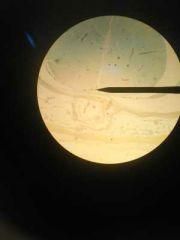
|
|
|
MOTOR CELLS |
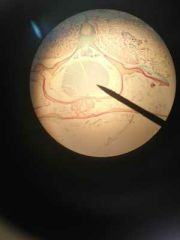
|
|

|
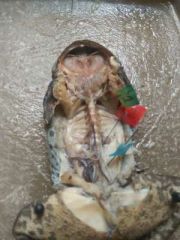
|
|
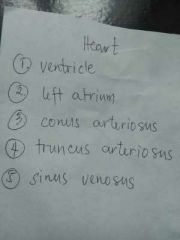
|
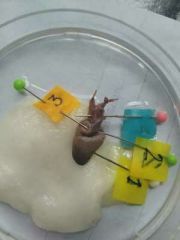
|
|
|
CAUDA EQUINA, ROOTS OF THE SPINAL NERVES |
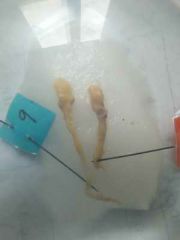
|
|
|
FEMORAL VEIN |
It branches from the renal portal vein which is the outer of the two branches which is larger than the inner one. It can be traced posterioly to the lower portions of the hindlimbs. |
|
|
SCIATIC VEIN |
The inner branch of the renal portal vein parallel to the femoral vein. |
|
|
PELVIC VEIN |
The ventral branch of the femoral vein. |
|
|
VENTRAL ABDOMINAL VEIN |
The union of the two pelvic veins which runs along the posterior wall of the body cavity towards the median ventral line immediately below the abdominal wall joining the hepatic portal vein at the level of the liver. |
|
|
VESICAL VEIN |
This is the tributary coming from the urinary bladder and several small veins from the muscle of the ventral body wall. |
|
|
HEPATIC PORTAL SYSTEM |
Associated with the digestive system. |
|
|
HEPATIC PORTAL VEIN |
The large vein coming up through the substance at the pancreas and dividing on the portal surface of the liver. |
|
|
GASTRIC VEINS |
Coming from the stomach and two in number. |
|
|
RIGHT GASTRIC VEIN |
Comes the ventral surface of the stomach. |
|
|
LEFT GASTRIC VEIN |
Comes from the dorsal surface of the stomach. |
|
|
PANCREATIC VEIN |
Receiving blood from the pancreas |
|
|
INTESTINAL VEIN |
Coming from the small intestines, spreading fan-like. |
|
|
ANTERIOR HEMORRHOIDAL VEIN |
Coming from the large intestine. |
|
|
SPLENIC OR LINEAL VEIN |
A short and small vein coming from the spleen and emptying into the intestinal vein. |
|
|
PULMONARY VEINS |
Two short straight vessels found running from the inner border of the base of each lung obliquely towards the sinus venosus. |
|
|
ARTERIAL SYSTEM |
Carries blood away from the heart toward the different parts of the body. |
|
|
CONUS ARTERIOSUS |
The swollen structure arising from the base of the right side of the ventricle and passing obliquely across the a auricles. |
|
|
TRUNCUS ARTERIOSUS |
These are the two branches of the CONUS ARTERIOSUS |
|
|
CAROTID or COMMON CAROTID ARTERY |
The most anterior of the three arches. |
|
|
EXTERNAL CAROTID ARTERY or LINGUAL ARTERY |
A smaller medial branch which supplies blood from the tongue, hyoid apparatus, thyroid gland, etc. |
|
|
INTERNAL CAROTID ARTERY |
At the point of forking locate a pigmented oval body, the carotid gland. |
|
|
SYSTEMIC ARCH |
The middle arch. The left and right arches pass laterally and dorsally and seem to disappear among the mass of tissue in this region. |
|
|
LARYNGEAL ARTERY |
The first small branch from the systemic arch which goes to the laryngeal prominence and also supplies to the esophagus. |
|
|
OCCIPITO-VERTEBRAL ARTERY |
A large branch that the systemic artery gives. |
|
|
VERTEBRAL ARTERY |
This artery proceeds alongside the vertebral column on the dorsal part. |
|
|
SUBCLAVIAN ARTERY |
Goes to the forelimbs to several muscles of the optic region. |
|
|
DORSAL AORTA |
Branch of the systemic arch that grows out to the nearby region of the esophagus, the ESOPHAGEAL ARTERY. |
|
|
COELIACO-MESENTERIC ARTERY |
A big branch to the digestive organs immediately after the dorsal aorta. |
|
|
COELIAC ARTERY |
The anterior branch of the coeliaco-mesentery which gives 3 branches. |
|
|
LEFT GASTRIC ARTERY |
Going to the ventral side of the stomach. |
|
|
RIGHT GASTRIC ARTERY |
Going to the dorsal side of the stomach and pancreas. |
|
|
HEPATIC ARTERY |
Going to the liver and the gall bladder. |
|
|
ANTERIOR MESENTERIC ARTERY |
The posterior branch of the COELIACO mesentery. |
|
|
SPLENIC ARTERY or LINEAL ARTERY |
A branch coming from the anterior MESENTERIC artery followed by a duodenal branch to the duodenum, and continues postetiorly from a distance. |
|
|
ANTERIOR HAEMORRHOIDAL ARTERY |
A branch from the splenic artery at a distance from the duodenum and then splits into three or four smaller arteries. |
|
|
UROGENITAL ARTERY |
Supply the kidneys, fat bodies and the gonads and their ducts. |
|
|
LUMBAR ARTERY |
At the region in the kidneys, gonads, and ducts, this go to the dorsal body wall, originating from the dorsal aorta. |
|
|
COMMON ILIAC ARTERY |
Small posterior MESENTERIC artery that goes to the posterior portion of the large intestine. |
|
|
EPIGASTRICO-VESICAL ARTERY |
It supplies branches to the muscles of the lateral ventral abdominal wall, urinary bladder and cloaca. |
|
|
PRECAVAL VEIN |
From the sv, it extends laterally along the border of the auricle and then passes through the pleuroperitoneal membrane about 1cm away from the heart. |
|
|
LINGUAL VEIN |
The anterior and medial branch draining blood from the tongue, hyoid and floor of the buccal cavity. |

